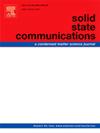钬(Ho)和钬(Ho, Mn)共取代对铋铁氧体磁性和磁电性能的影响
IF 2.4
4区 物理与天体物理
Q3 PHYSICS, CONDENSED MATTER
引用次数: 0
摘要
铋铁氧体(BFO)掺杂和共掺杂钬(Ho)和锰(Mn),因其在环境温度下的多铁性和磁电性而受到关注,使其成为自旋电子学、光电子学和存储设备中有前途的候选者。本研究研究了原始BiFeO3及其掺杂Ho和共掺杂(Ho, Mn)的变体的磁性和磁电特性。这项工作为理解(Ho, Mn)共掺杂BFO中影响带隙和磁电耦合机制的最新进展提供了见解,特别关注了掺杂剂在调节其多铁性行为中的作用。利用x射线衍射(XRD)和透射电子显微镜(TEM)检查了结构和形态特性,同时利用x射线光电子能谱(XPS)分析了能带和分子结构。漫反射光谱显示,随着铁位点上Mn取代的增加,带隙逐渐减少,增强了材料的光电应用潜力。磁滞(M-H)和温度相关磁化(M-T)研究表明,Ho掺杂增强了铁磁性能,而在Mn共掺杂的样品中观察到反铁磁有序,特别是在较低温度下。与纯BFO相比,掺钬可以增强磁电耦合,但耦合强度随着Mn含量的增加而降低。这些发现表明,定制(Ho, Mn)掺杂可以显著影响BFO的磁电和光学性质,为优化BFO在高级多功能应用中的应用提供了途径。本文章由计算机程序翻译,如有差异,请以英文原文为准。

Effect of holmium (Ho) and (Ho, Mn) co-substitution on the magnetic and magnetoelectric properties of bismuth ferrites
Bismuth Ferrites (BFO) doped and co-doped with Holmium (Ho) and Manganese (Mn) have gathered attention for their multiferroic and magnetoelectric properties at ambient temperature, positioning them as promising candidates for applications in spintronics, optoelectronics, and memory storage devices. This study investigates the magnetic and magnetoelectric characteristics of both pristine BiFeO and its variants doped with Ho and co-doped with (Ho, Mn). The work provides insights into recent advances in understanding the mechanisms influencing band gaps and magnetoelectric coupling in (Ho, Mn) co-doped BFO, with a particular focus on the role of dopants in modulating its multiferroic behaviour. Structural and morphological properties were examined using X-ray diffraction (XRD) and Transmission Electron Microscopy (TEM), while X-ray Photoelectron Spectroscopy (XPS) enabled an analysis of the energy bands and molecular structure. Diffuse reflectance spectroscopy reveals a progressive decrease in the band gap with increasing Mn substitution at the iron sites, enhancing the material’s potential for optoelectronic applications. Magnetic hysteresis (M-H) and temperature-dependent magnetization (M-T) studies demonstrate enhanced ferromagnetic properties with Ho doping, while antiferromagnetic ordering is observed in samples co-doped with Mn, especially at lower temperatures. Holmium doping is shown to increase magnetoelectric coupling relative to pure BFO, though the coupling strength diminishes with higher Mn levels. These findings suggest that tailored (Ho, Mn) doping can significantly influence the magnetoelectric and optical properties of BFO, offering pathways for optimizing BFO in advanced multifunctional applications.
求助全文
通过发布文献求助,成功后即可免费获取论文全文。
去求助
来源期刊

Solid State Communications
物理-物理:凝聚态物理
CiteScore
3.40
自引率
4.80%
发文量
287
审稿时长
51 days
期刊介绍:
Solid State Communications is an international medium for the publication of short communications and original research articles on significant developments in condensed matter science, giving scientists immediate access to important, recently completed work. The journal publishes original experimental and theoretical research on the physical and chemical properties of solids and other condensed systems and also on their preparation. The submission of manuscripts reporting research on the basic physics of materials science and devices, as well as of state-of-the-art microstructures and nanostructures, is encouraged.
A coherent quantitative treatment emphasizing new physics is expected rather than a simple accumulation of experimental data. Consistent with these aims, the short communications should be kept concise and short, usually not longer than six printed pages. The number of figures and tables should also be kept to a minimum. Solid State Communications now also welcomes original research articles without length restrictions.
The Fast-Track section of Solid State Communications is the venue for very rapid publication of short communications on significant developments in condensed matter science. The goal is to offer the broad condensed matter community quick and immediate access to publish recently completed papers in research areas that are rapidly evolving and in which there are developments with great potential impact.
 求助内容:
求助内容: 应助结果提醒方式:
应助结果提醒方式:


